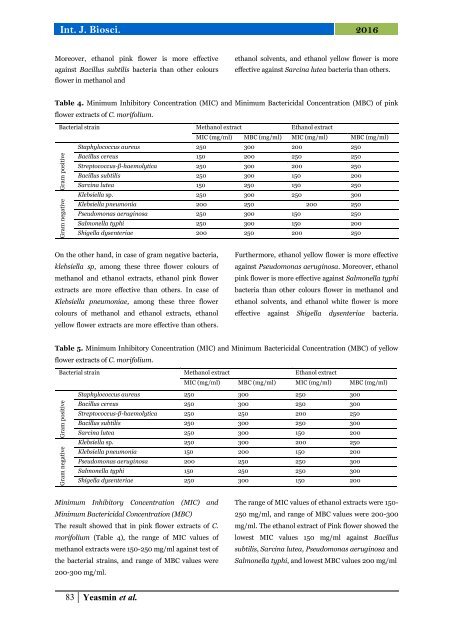Evaluation of antibacterial activity of three flower colours Chrysanthemum morifolium Ramat. against multi-drug resistant human pathogenic bacteria
The present investigation was carried out to evaluate the anitibacterial activity of flower extracts of three colours (pink, yellow and white) of Chrysanthemum morifolium Ramat. against five Gram positive bacteria viz., Staphylococcus aureus, Bacillus cereus, Streptococcus-β-haemolytica, Bacillus subtilis, Sarcina lutea and five Gram negative bacteria viz., Klebsiella sp, Klebsiella pneumonia, Pseudomonas aeruginosa, Salmonella typhi, Shigella dysenteriae. Between the two extracts (ethanol and methanol) the ethanol extracts of white flower was more effective than pink and yellow flower of C. morifolium. The ethanol extracts of white flower was showed the highest zone of inhibition (24.40 mm) against Shigella dysenteriae, the lowest MIC value (150 mg/ml) was against Shigella dysenteriae and Streptococcus-β-haemolytica and the lowest MBC value (200 mg/ml) was against Shigella dysenteriae. MIC and MBC of the extracts have ranged from 150-250 mg/ml and 200-300 mg/ml respectively. The lowest MIC and MBC values have observed against Shigella dysenteriae. For pink and yellow flower extracts, statistical results indicated that there are significant differences among bacterial species, solvent and bacterial strain, but no significant differences are shown in replication. But in case of yellow flower, there are significant differences among bacterial species, solvent, replication and bacterial strain. In addition, interaction between bacterial species and solvent appears to be significantly different.
The present investigation was carried out to evaluate the anitibacterial activity of flower extracts of three colours (pink, yellow and white) of Chrysanthemum morifolium Ramat. against five Gram positive bacteria viz., Staphylococcus aureus, Bacillus cereus, Streptococcus-β-haemolytica, Bacillus subtilis, Sarcina lutea and five Gram negative bacteria viz., Klebsiella sp, Klebsiella pneumonia, Pseudomonas aeruginosa, Salmonella typhi, Shigella dysenteriae. Between the two extracts (ethanol and methanol) the ethanol extracts of white flower was
more effective than pink and yellow flower of C. morifolium. The ethanol extracts of white flower was showed the highest zone of inhibition (24.40 mm) against Shigella dysenteriae, the lowest MIC value (150 mg/ml) was against Shigella dysenteriae and Streptococcus-β-haemolytica and the lowest MBC value (200 mg/ml) was against Shigella dysenteriae. MIC and MBC of the extracts have ranged from 150-250 mg/ml and 200-300 mg/ml respectively. The lowest MIC and MBC values have observed against Shigella dysenteriae. For pink and yellow flower extracts, statistical results indicated that there are significant differences among bacterial species, solvent and bacterial strain, but no significant differences are shown in replication. But in case of yellow flower, there are significant differences among bacterial species, solvent, replication and bacterial strain. In addition, interaction between bacterial species and solvent appears to be significantly different.
Create successful ePaper yourself
Turn your PDF publications into a flip-book with our unique Google optimized e-Paper software.
Int. J. Biosci. 2016<br />
Moreover, ethanol pink <strong>flower</strong> is more effective<br />
<strong>against</strong> Bacillus subtilis <strong>bacteria</strong> than other <strong>colours</strong><br />
<strong>flower</strong> in methanol and<br />
ethanol solvents, and ethanol yellow <strong>flower</strong> is more<br />
effective <strong>against</strong> Sarcina lutea <strong>bacteria</strong> than others.<br />
Table 4. Minimum Inhibitory Concentration (MIC) and Minimum Bactericidal Concentration (MBC) <strong>of</strong> pink<br />
<strong>flower</strong> extracts <strong>of</strong> C. <strong>morifolium</strong>.<br />
Bacterial strain Methanol extract Ethanol extract<br />
MIC (mg/ml) MBC (mg/ml) MIC (mg/ml) MBC (mg/ml)<br />
Staphylococcus aureus 250 300 200 250<br />
Gram negative Gram positive<br />
Bacillus cereus 150 200 250 250<br />
Streptococcus-β-haemolytica 250 300 200 250<br />
Bacillus subtilis 250 300 150 200<br />
Sarcina lutea 150 250 150 250<br />
Klebsiella sp. 250 300 250 300<br />
Klebsiella pneumonia 200 250 200 250<br />
Pseudomonas aeruginosa 250 300 150 250<br />
Salmonella typhi 250 300 150 200<br />
Shigella dysenteriae 200 250 200 250<br />
On the other hand, in case <strong>of</strong> gram negative <strong>bacteria</strong>,<br />
klebsiella sp, among these <strong>three</strong> <strong>flower</strong> <strong>colours</strong> <strong>of</strong><br />
methanol and ethanol extracts, ethanol pink <strong>flower</strong><br />
extracts are more effective than others. In case <strong>of</strong><br />
Klebsiella pneumoniae, among these <strong>three</strong> <strong>flower</strong><br />
<strong>colours</strong> <strong>of</strong> methanol and ethanol extracts, ethanol<br />
yellow <strong>flower</strong> extracts are more effective than others.<br />
Furthermore, ethanol yellow <strong>flower</strong> is more effective<br />
<strong>against</strong> Pseudomonas aeruginosa. Moreover, ethanol<br />
pink <strong>flower</strong> is more effective <strong>against</strong> Salmonella typhi<br />
<strong>bacteria</strong> than other <strong>colours</strong> <strong>flower</strong> in methanol and<br />
ethanol solvents, and ethanol white <strong>flower</strong> is more<br />
effective <strong>against</strong> Shigella dysenteriae <strong>bacteria</strong>.<br />
Table 5. Minimum Inhibitory Concentration (MIC) and Minimum Bactericidal Concentration (MBC) <strong>of</strong> yellow<br />
<strong>flower</strong> extracts <strong>of</strong> C. <strong>morifolium</strong>.<br />
Bacterial strain Methanol extract Ethanol extract<br />
MIC (mg/ml) MBC (mg/ml) MIC (mg/ml) MBC (mg/ml)<br />
Staphylococcus aureus 250 300 250 300<br />
Gram negative Gram positive<br />
Bacillus cereus 250 300 250 300<br />
Streptococcus-β-haemolytica 250 250 200 250<br />
Bacillus subtilis 250 300 250 300<br />
Sarcina lutea 250 300 150 200<br />
Klebsiella sp. 250 300 200 250<br />
Klebsiella pneumonia 150 200 150 200<br />
Pseudomonas aeruginosa 200 250 250 300<br />
Salmonella typhi 150 250 250 300<br />
Shigella dysenteriae 250 300 150 200<br />
Minimum Inhibitory Concentration (MIC) and<br />
Minimum Bactericidal Concentration (MBC)<br />
The result showed that in pink <strong>flower</strong> extracts <strong>of</strong> C.<br />
<strong>morifolium</strong> (Table 4), the range <strong>of</strong> MIC values <strong>of</strong><br />
methanol extracts were 150-250 mg/ml <strong>against</strong> test <strong>of</strong><br />
the <strong>bacteria</strong>l strains, and range <strong>of</strong> MBC values were<br />
200-300 mg/ml.<br />
The range <strong>of</strong> MIC values <strong>of</strong> ethanol extracts were 150-<br />
250 mg/ml, and range <strong>of</strong> MBC values were 200-300<br />
mg/ml. The ethanol extract <strong>of</strong> Pink <strong>flower</strong> showed the<br />
lowest MIC values 150 mg/ml <strong>against</strong> Bacillus<br />
subtilis, Sarcina lutea, Pseudomonas aeruginosa and<br />
Salmonella typhi, and lowest MBC values 200 mg/ml<br />
83 Yeasmin et al.


















